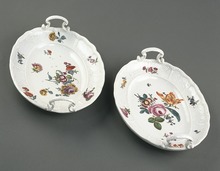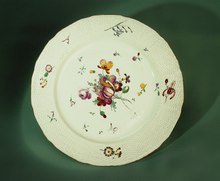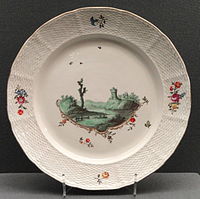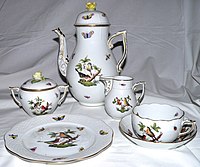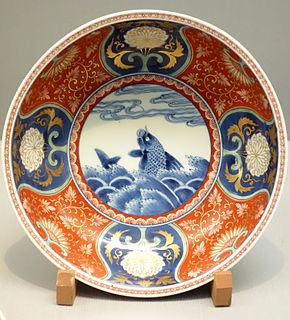
Imari ware is a Western term for a brightly-coloured style of Arita ware Japanese export porcelain made in the area of Arita, in the former Hizen Province, northwestern Kyūshū. They were exported to Europe in large quantities, especially between the second half of the 17th century and the first half of the 18th century.

Kakiemon is a style of Japanese porcelain, with overglaze decoration called "enameled" ceramics. It was originally produced at the factories around Arita, in Japan's Hizen province from the Edo period's mid-17th century onwards. The style shares much in common with the Chinese "Famille Verte" style. The quality of its decoration was highly prized in the West and widely imitated by major European porcelain manufacturers during the Rococo period.

"Blue and white pottery" covers a wide range of white pottery and porcelain decorated under the glaze with a blue pigment, generally cobalt oxide. The decoration is commonly applied by hand, originally by brush painting, but nowadays by stencilling or by transfer-printing, though other methods of application have also been used. The cobalt pigment is one of the very few that can withstand the highest firing temperatures that are required, in particular for porcelain, which partly accounts for its long-lasting popularity. Historically, many other colours required overglaze decoration and then a second firing at a lower temperature to fix that.

An hua is a term used in Chinese ceramics meaning secret or veiled decoration; the designs being visible through transmitted light, produced either by incising the design into the porcelain before glazing and firing or by delicate slip-trailing in white slip on the porcelain body. It is also called "secret" or "hidden decoration".
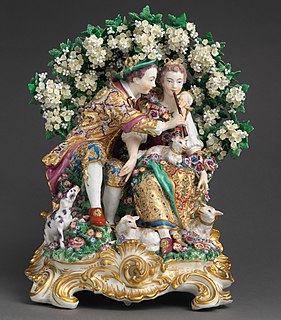
Chelsea porcelain is the porcelain made by the Chelsea porcelain manufactory, the first important porcelain manufactory in England, established around 1743–45, and operating independently until 1770, when it was merged with Derby porcelain. It made soft-paste porcelain throughout its history, though there were several changes in the "body" material and glaze used. Its wares were aimed at a luxury market, and its site in Chelsea, London, was close to the fashionable Ranelagh Gardens pleasure ground, opened in 1742.
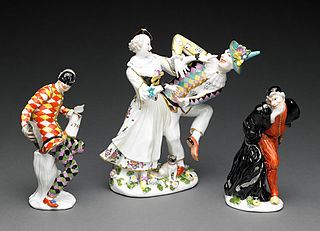
Meissen porcelain or Meissen china was the first European hard-paste porcelain. Early experiments were done in 1708 by Ehrenfried Walther von Tschirnhaus. After his death that October, Johann Friedrich Böttger continued von Tschirnhaus's work and brought this type of porcelain to the market, financed by Augustus the Strong, King of Poland and Elector of Saxony. The production of porcelain in the royal factory at Meissen, near Dresden, started in 1710 and attracted artists and artisans to establish, arguably, the most famous porcelain manufacturer known throughout the world. Its signature logo, the crossed swords, was introduced in 1720 to protect its production; the mark of the swords is reportedly one of the oldest trademarks in existence. Dresden porcelain was once the usual term for these wares, until the Oberlandesgericht decided in favour of the Saxon Porcelain Manufactory Dresden, which alone was then allowed to use the name Dresden Porcelain.

Ding ware, Ting ware or Dingyao are Chinese ceramics, mostly porcelain, that were produced in the prefecture of Dingzhou in Hebei in northern China. The main kilns were at Jiancicun or Jianci in Quyang County. They were produced between the Tang and Yuan dynasties of imperial China, though their finest period was in the 11th century, under the Northern Song. The kilns "were in almost constant operation from the early eighth until the mid-fourteenth century."

Sprigging or sprigged decoration is a technique for decorating pottery with low relief shapes made separately from the main body and applied to it before firing. Usually thin press moulded shapes are applied to greenware or bisque. The resulting pottery is termed sprigged ware, and the added piece is a "sprig". The technique may also be described by terms such as "applied relief decoration", especially in non-European pottery.

Edmé Samson, founder of the porcelain firm Samson, Edmé et Cie, was a famous copyist of porcelain and pottery. The firm produced high-quality copies or imitations of earlier styles of porcelain, mainly 18th-century European and Chinese and Japanese porcelain, but also earlier styles such as Italian maiolica.
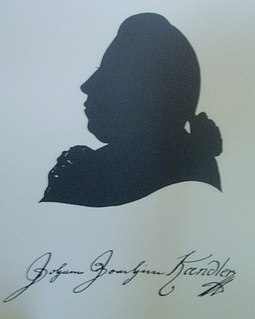
Johann Joachim Kändler was a German sculptor who became the most important modeller of the Meissen porcelain manufactury, and arguably of all European porcelain. He worked at Meissen for over 40 years, from 1731 until his death in 1775.
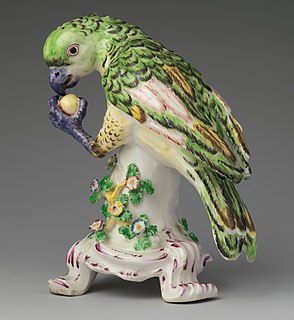
The Bow porcelain factory was an emulative rival of the Chelsea porcelain factory in the manufacture of early soft-paste porcelain in Great Britain. The two London factories were the first in England. It was originally located near Bow, in what is now the London Borough of Tower Hamlets, but by 1749 it had moved to "New Canton", sited east of the River Lea, and then in Essex, now in the London Borough of Newham.

Cizhou ware or Tz'u-chou ware is a term for a wide range of Chinese ceramics from between the late Tang dynasty and the early Ming dynasty, but especially associated with the Northern Song to Yuan period in the 11–14th century. It has been increasingly realized that a very large number of sites in northern China produced these wares, and their decoration is very variable, but most characteristically uses black and white, in a variety of techniques. For this reason Cizhou-type is often preferred as a general term. All are stoneware in Western terms, and "high-fired" or porcelain in Chinese terms. They were less high-status than other types such as celadons and Jun ware, and are regarded as "popular", though many are finely and carefully decorated.
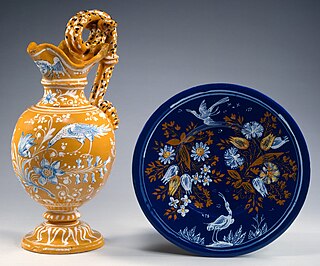
The city of Nevers, Nièvre, now in the Bourgogne-Franche-Comté region in central France, was a centre for manufacturing faience, or tin-glazed earthenware pottery, between around 1580 and the early 19th century. Production of Nevers faience then gradually died down to a single factory, before a revival in the 1880s. In 2017, there were still two potteries making it in the city, after a third had closed. However the quality and prestige of the wares has gradually declined, from a fashionable luxury product for the court, to a traditional regional speciality using styles derived from the past.

French porcelain has a history spanning a period from the 17th century to the present. The French were heavily involved in the early European efforts to discover the secrets of making the hard-paste porcelain known from Chinese and Japanese export porcelain. They succeeded in developing soft-paste porcelain, but Meissen porcelain was the first to make true hard-paste, around 1710, and the French took over 50 years to catch up with Meissen and the other German factories.
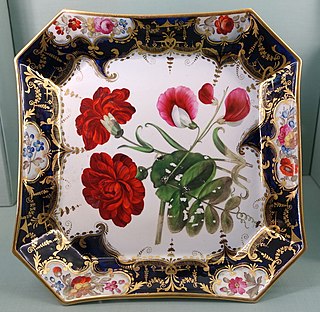
Coalport, Shropshire, England was a centre of porcelain and pottery production between about 1795 and 1926, with the Coalport porcelain brand continuing to be used up to the present. The opening in 1792 of the Coalport Canal, which joins the River Severn at Coalport, had increased the attractiveness of the site, and from 1800 until a merger in 1814 there were two factories operating, one on each side of the canal, making rather similar wares which are now often difficult to tell apart.

Gaspard Robert (1722-1799) was the founder of a factory that made faience in Marseille, France, between 1750 and 1793.

China painting, or porcelain painting, is the decoration of glazed porcelain objects such as plates, bowls, vases or statues. The body of the object may be hard-paste porcelain, developed in China in the 7th or 8th century, or soft-paste porcelain, developed in 18th-century Europe. The broader term ceramic painting includes painted decoration on lead-glazed earthenware such as creamware or tin-glazed pottery such as maiolica or faience.

Ceramic art is art made from ceramic materials, including clay. It may take forms including artistic pottery, including tableware, tiles, figurines and other sculpture. As one of the plastic arts, ceramic art is one of the visual arts. While some ceramics are considered fine art, such as pottery or sculpture, most are considered to be decorative, industrial or applied art objects. Ceramics may also be considered artefacts in archaeology. Ceramic art can be made by one person or by a group of people. In a pottery or ceramic factory, a group of people design, manufacture and decorate the art ware. Products from a pottery are sometimes referred to as "art pottery". In a one-person pottery studio, ceramists or potters produce studio pottery.

The Swan Service is a large service of baroque Meissen porcelain which was made for the First Minister of the Electorate of Saxony and favourite of king Augustus III of Poland, Heinrich von Brühl. Augustus had made Brühl the Supervisor of the Meissen works in 1733, then in August 1739 its director. The Swan Service has been called "the most famous high baroque production in Meissen porcelain", "a triumph of modelling and firing", and "the most fabulous tableware conceived in porcelain". After earlier work with prototypes, the Meissen designers and modellers Johann Joachim Kändler, Johann Friedrich Eberlein and Johann Gottlieb Ehder created the service, which consists of over 2,200 individual pieces, between 1737 and 1741 or 1742.

Vezzi porcelain is porcelain made by the Vezzi porcelain factory in Venice, Italy, established in 1720 by the Vezzi family. It was the first porcelain factory in Italy, after the experimental Medici porcelain of the 16th century. It operated only until 1727, so surviving pieces are few, probably fewer than 200. It made "true" hard-paste porcelain, and was only the third factory in Europe to do so, hiring technicians from Meissen porcelain and Vienna porcelain, the first two makers.
